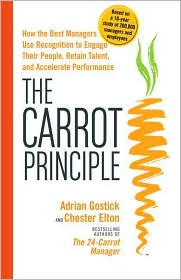The Carrot Principle: How the Best Managers Use Recognition to Engage Their Employees, Retain Talent, and Drive Performance - Gostick & Elton

This was a book recommended to my by the CEO of my firm. While the core message of the book was something I found admirable, overall I found that the book echoed the title - needlessly long and cumbersome.
ISBN: 9780743290098
format: Hardcover
pages: 224
publisher: Simon & Schuster
pub. date: 2007-01-02
started reading: 2008-12-22
finished reading: 2008-12-25
The core message of the book is that in order to get the best out of people that you manage, you need to reward them. This doesn't mean you need to do so with tangible things (though depending on the person, that may be the solution), but just that in general, a little recognition goes a long way.
There. In the space of a two sentence paragraph I have told you most of what you will take away from the book, and odds are good that if you have been in a managerial role for any length of time, this is something you already know.
The book does go on at some length about the qualities of good leadership, and provides concrete recommendations for how to reward people (both in terms of frequency and raw cash value) however I found most of their statistics to be the sort of pseudo-science that often offends my delicate mathematician sensibilities.
When people start tossing around numbers like '80% of employees aren't...' and '65% of people feel that...' and then drawing conclusions from it, I can't help but be reminded of the satirical cartoon that proudly states '95% of all statistics are made up'.
While the authors of the book certainly have an impressive pedigree of consulting experience with companies like KPMG and DHL, it does not unfortunately make their knowledge applicable to all companies and all situations.
One of the telling signs comes from Chapter 10, which really should be an appendix and not a chapter. It is a listing of 125 suggestions of ways to reward employees. They preface the chapter with a statement that 'not all of these will work for your company, or with your people, so these are just recommendations'.
What these are really is the other 30 pages they needed to flush the book out and satisfy the publisher (and the end consumer) that what they were buying had some content to it. In otherwords, there is a limit to how far you can wordsmith a simple idea and heavy amounts of filler was required to make this a book and not a pamphlet.
The authors themselves seem aware of this in how they set up a lot of the chapter introductions with excuses and quid pro quos. Part of me can't help but think that perhaps their best lesson is that if you want to make a lot of money, invest in taking one simple idea and transforming it into a business book and sell a million copies.
Kudos guys for escaping the consulting world. This is not a book I would recommend.


0 Comments:
Post a Comment
<< Home